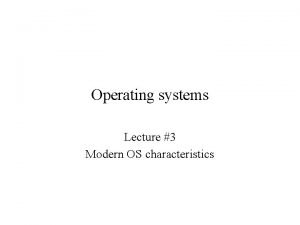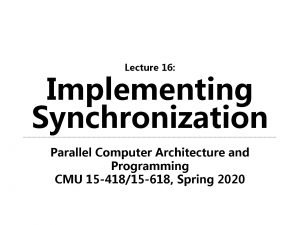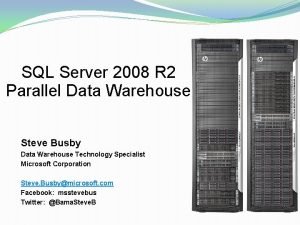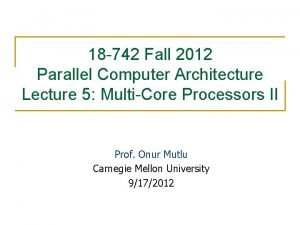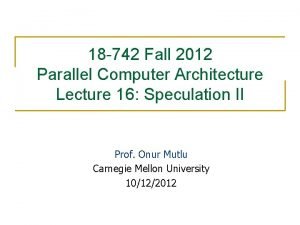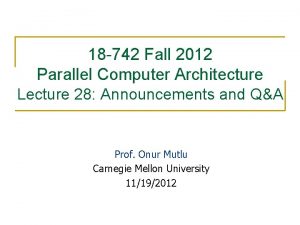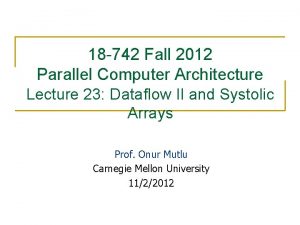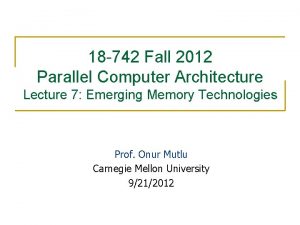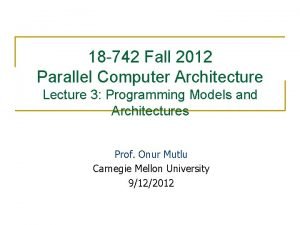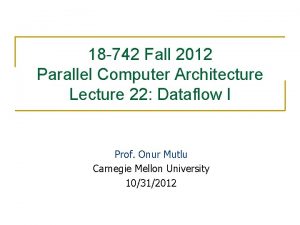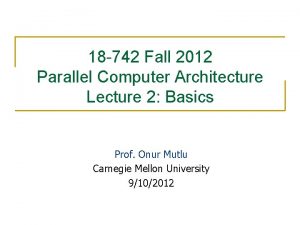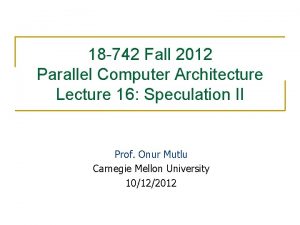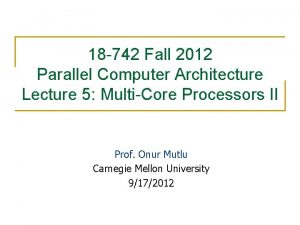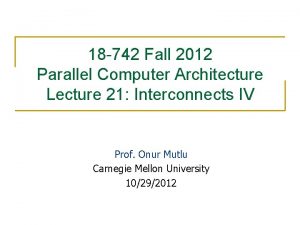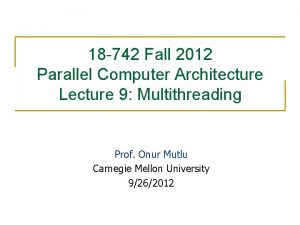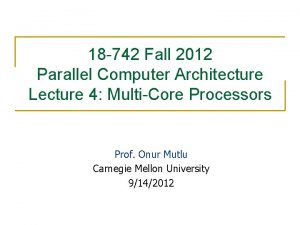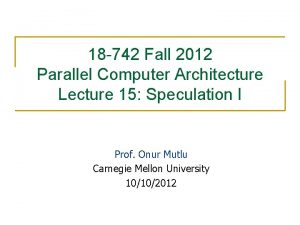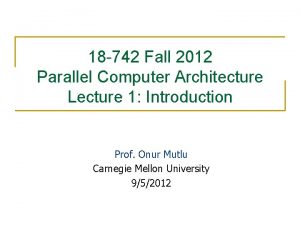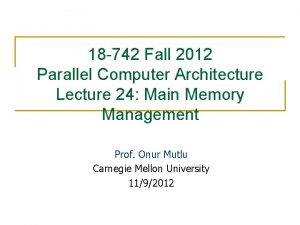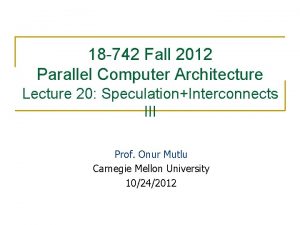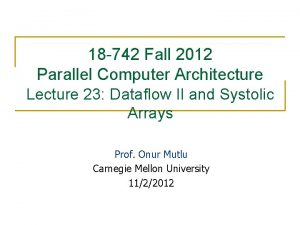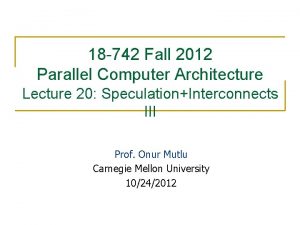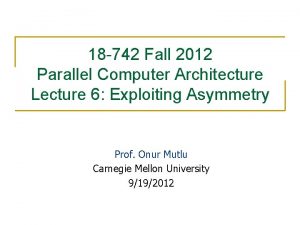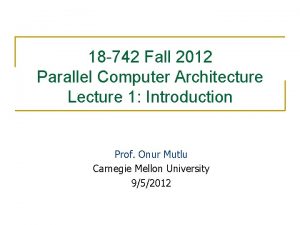18 742 Fall 2012 Parallel Computer Architecture Lecture























- Slides: 23

18 -742 Fall 2012 Parallel Computer Architecture Lecture 4: Multi-Core Processors Prof. Onur Mutlu Carnegie Mellon University 9/14/2012

Reminder: Reviews Due Sunday n n Sunday, September 16, 11: 59 pm. Suleman et al. , “Accelerating Critical Section Execution with Asymmetric Multi-Core Architectures, ” ASPLOS 2009. Suleman et al. , “Data Marshaling for Multi-core Architectures, ” ISCA 2010. Joao et al. , “Bottleneck Identification and Scheduling in Multithreaded Applications, ” ASPLOS 2012. 2

Multi-Core Processors 3

Moore’s Law Moore, “Cramming more components onto integrated circuits, ” Electronics, 1965. 4

5

Multi-Core n n n Idea: Put multiple processors on the same die. Technology scaling (Moore’s Law) enables more transistors to be placed on the same die area What else could you do with the die area you dedicate to multiple processors? q q Have a bigger, more powerful core Have larger caches in the memory hierarchy Simultaneous multithreading Integrate platform components on chip (e. g. , network interface, memory controllers) 6

Why Multi-Core? n Alternative: Bigger, more powerful single core q Larger superscalar issue width, larger instruction window, more execution units, large trace caches, large branch predictors, etc + Improves single-thread performance transparently to programmer, compiler - Very difficult to design (Scalable algorithms for improving single -thread performance elusive) - Power hungry – many out-of-order execution structures consume significant power/area when scaled. Why? - Diminishing returns on performance - Does not significantly help memory-bound application performance (Scalable algorithms for this elusive) 7

Large Superscalar vs. Multi-Core n Olukotun et al. , “The Case for a Single-Chip Multiprocessor, ” ASPLOS 1996. 8

Multi-Core vs. Large Superscalar n Multi-core advantages + Simpler cores more power efficient, lower complexity, easier to design and replicate, higher frequency (shorter wires, smaller structures) + Higher system throughput on multiprogrammed workloads reduced context switches + Higher system throughput in parallel applications n Multi-core disadvantages - Requires parallel tasks/threads to improve performance (parallel programming) - Resource sharing can reduce single-thread performance - Shared hardware resources need to be managed - Number of pins limits data supply for increased demand 9

Large Superscalar vs. Multi-Core n n Olukotun et al. , “The Case for a Single-Chip Multiprocessor, ” ASPLOS 1996. Technology push q Instruction issue queue size limits the cycle time of the superscalar, Oo. O processor diminishing performance n q n Quadratic increase in complexity with issue width Large, multi-ported register files to support large instruction windows and issue widths reduced frequency or longer RF access, diminishing performance Application pull q q q Integer applications: little parallelism? FP applications: abundant loop-level parallelism Others (transaction proc. , multiprogramming): CMP better fit 10

Comparison Points… 11

Why Multi-Core? n Alternative: Bigger caches + Improves single-thread performance transparently to programmer, compiler + Simple to design - Diminishing single-thread performance returns from cache size. Why? - Multiple levels complicate memory hierarchy 12

Cache vs. Core 13

Why Multi-Core? n Alternative: (Simultaneous) Multithreading + + Exploits thread-level parallelism (just like multi-core) Good single-thread performance with SMT No need to have an entire core for another thread Parallel performance aided by tight sharing of caches - Scalability is limited: need bigger register files, larger issue width (and associated costs) to have many threads complex with many threads - Parallel performance limited by shared fetch bandwidth - Extensive resource sharing at the pipeline and memory system reduces both single-thread and parallel application performance 14

Why Multi-Core? n Alternative: Integrate platform components on chip instead + Speeds up many system functions (e. g. , network interface cards, Ethernet controller, memory controller, I/O controller) - Not all applications benefit (e. g. , CPU intensive code sections) 15

Why Multi-Core? n Alternative: More scalable superscalar, out-of-order engines q Clustered superscalar processors (with multithreading) + Simpler to design than superscalar, more scalable than simultaneous multithreading (less resource sharing) + Can improve both single-thread and parallel application performance - Diminishing performance returns on single thread: Clustering reduces IPC performance compared to monolithic superscalar. Why? - Parallel performance limited by shared fetch bandwidth - Difficult to design 16

Clustered Superscalar+Oo. O Processors n Clustering (e. g. , Alpha 21264 integer units) q q + + + -- Divide the scheduling window (and register file) into multiple clusters Instructions steered into clusters (e. g. based on dependence) Clusters schedule instructions out-of-order, within cluster scheduling can be in-order Inter-cluster communication happens via register files (no full bypass) Smaller scheduling windows, simpler wakeup algorithms Smaller ports into register files Faster within-cluster bypass Extra delay when instructions require across-cluster communication 17

Clustering (I) n Scheduling within each cluster can be out of order 18

Clustering (II) 19

Clustering (III) Each scheduler is a FIFO + Simpler + Can have N FIFOs (Oo. O w. r. t. each other) + Reduces scheduling complexity -- More dispatch stalls Inter-cluster bypass: Results produced by an FU in Cluster 0 is not individually forwarded to each FU in another cluster. n Palacharla et al. , “Complexity Effective Superscalar Processors, ” ISCA 1997. 20

Why Multi-Core? n Alternative: Traditional symmetric multiprocessors + Smaller die size (for the same processing core) + More memory bandwidth (no pin bottleneck) + Fewer shared resources less contention between threads - Long latencies between cores (need to go off chip) shared data accesses limit performance parallel application scalability is limited - Worse resource efficiency due to less sharing worse power/energy efficiency 21

Why Multi-Core? n Other alternatives? q q Dataflow? Vector processors (SIMD)? Integrating DRAM on chip? Reconfigurable logic? (general purpose? ) 22

Review: Multi-Core Alternatives n n n Bigger, more powerful single core Bigger caches (Simultaneous) multithreading Integrate platform components on chip instead More scalable superscalar, out-of-order engines Traditional symmetric multiprocessors Dataflow? Vector processors (SIMD)? Integrating DRAM on chip? Reconfigurable logic? (general purpose? ) Other alternatives? 23
 Computer architecture lecture notes
Computer architecture lecture notes Isa definition computer
Isa definition computer D.m. 742 del 2017 slide
D.m. 742 del 2017 slide Calculate the density of xenon gas at a pressure of 742
Calculate the density of xenon gas at a pressure of 742 Sga-742
Sga-742 Characteristics of modern os
Characteristics of modern os Write 680 705 in expanded form
Write 680 705 in expanded form 142 984 km in miles
142 984 km in miles 01:640:244 lecture notes - lecture 15: plat, idah, farad
01:640:244 lecture notes - lecture 15: plat, idah, farad Synchronization in computer architecture
Synchronization in computer architecture Example of interrupt in os
Example of interrupt in os Buses in computer architecture
Buses in computer architecture Microsoft sql server 2012 parallel data warehouse
Microsoft sql server 2012 parallel data warehouse Computer architecture and organization difference
Computer architecture and organization difference Design of a basic computer
Design of a basic computer Cloud computing lecture
Cloud computing lecture Computer security 161 cryptocurrency lecture
Computer security 161 cryptocurrency lecture Computer-aided drug design lecture notes
Computer-aided drug design lecture notes A pair of unlike parallel forces
A pair of unlike parallel forces Type lines fingerprint
Type lines fingerprint Parallel and non parallel structure
Parallel and non parallel structure Parallel sentence structure
Parallel sentence structure Parallel and non parallel structure
Parallel and non parallel structure Pipo truth table
Pipo truth table





